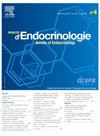Chapter 2: Primary Hyperparathyroidism: diagnosis
IF 2.9
3区 医学
Q3 ENDOCRINOLOGY & METABOLISM
引用次数: 0
Abstract
Primary hyperparathyroidism is now predominantly an asymptomatic pathology, as blood calcium assay has become systematic. Diagnosis therefore requires screening for target organ damage when this is not already indicative of primary hyperparathyroidism. Classical clinical manifestations include bone, kidney and muscle signs, and are characterized by reversibility after parathyroid surgery. Their presence requires blood calcium assay. Non-classical manifestations include cardiovascular, digestive and neuropsychological signs, which are not known to be reversible after surgery. Positive diagnosis is biological, based on a parathyroid hormone value that is inappropriate to the blood calcium value. The typical form combines hypercalcemia, elevated parathyroid hormone and increased calciuria or calcium excretion fraction. Atypical forms combine either hypercalcemia and normal parathyroid hormone level, or normal calcemia with increased parathyroid hormone level, not necessarily secondary to another cause, such as 25(OH) vitamin D deficiency. The oral calcium loading test and the Pro-FHH score are contributive to diagnosis in atypical forms.
第二章:原发性甲状旁腺功能亢进的诊断。
原发性甲状旁腺功能亢进现在主要是一种无症状的病理,因为血钙测定已成为系统的。因此,诊断需要筛查靶器官损伤,当这还不是原发性甲状旁腺功能亢进的指示。典型临床表现包括骨、肾和肌肉征象,甲状旁腺手术后具有可逆性。它们的存在需要血钙测定。非经典表现包括心血管、消化和神经心理症状,这些症状术后不可逆。阳性诊断是生物学依据,甲状旁腺激素值与血钙值不合适。典型的形式包括高钙血症、甲状旁腺激素升高和钙尿量或钙排泄分数增加。非典型形式合并高钙血症和正常甲状旁腺激素水平,或正常钙血症和甲状旁腺激素水平升高,不一定继发于其他原因,如25(OH)维生素D缺乏。口腔钙负荷试验和Pro-FHH评分有助于非典型形式的诊断。
本文章由计算机程序翻译,如有差异,请以英文原文为准。
求助全文
约1分钟内获得全文
求助全文
来源期刊

Annales d'endocrinologie
医学-内分泌学与代谢
CiteScore
4.40
自引率
6.50%
发文量
311
审稿时长
50 days
期刊介绍:
The Annales d''Endocrinologie, mouthpiece of the French Society of Endocrinology (SFE), publishes reviews, articles and case reports coming from clinical, therapeutic and fundamental research in endocrinology and metabolic diseases. Every year, it carries a position paper by a work-group of French-language endocrinologists, on an endocrine pathology chosen by the Society''s Scientific Committee. The journal is also the organ of the Society''s annual Congress, publishing a summary of the symposia, presentations and posters. "Les Must de l''Endocrinologie" is a special booklet brought out for the Congress, with summary articles that are always very well received. And finally, we publish the high-level instructional courses delivered during the Henri-Pierre Klotz International Endocrinology Days. The Annales is a window on the world, keeping alert clinicians up to date on what is going on in diagnosis and treatment in all the areas of our specialty.
 求助内容:
求助内容: 应助结果提醒方式:
应助结果提醒方式:


